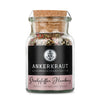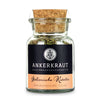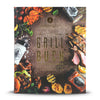Black & white pepper: what's the difference?
Of course you say now, the color! Some peppercorns are light, others dark - and you're not wrong about that. Of course, the white and black pepper differ in their color and therefore fit different dishes visually.
For example, the black seasoning goes better with dark, heavy sauces, as might a dark sauce thickener, but the white version simply works better with light sauces and dishes such as chicken! The light color is due to the processing process: After being harvested from the bush, the ripe, red grains are placed in a water bath for a good two weeks. They soften and the shell can be removed along with the pulp. The fruit shell that remains is beige to slightly yellowish and is dried during further processing. We provide you with the grains whole, which you can either use when cooking or grind beforehand in a mill or mortar. But are there more differences than just the color? After all, all variants, including the red and black ones, come from the same pepper plant!
Due to a different composition of the individual components in the small berries, the white pepper has a slightly less intense taste, but makes up for it with its spiciness. For some it is considered the hottest pepper of the many different varieties and is therefore the first choice when buying.
The correct use
Be careful! For more sensitive spiciness eaters, we recommend carefully dosing the white, dried grains. However, the pure spiciness and aroma are a real enrichment in the kitchen that you shouldn't miss out on. Basically, you can use it in a similar way to the black version, but you can also use it as a guide to the color of the food you want to season.
In a light spaghetti carbonara or hollandaise sauce, a mushroom risotto or a vegetable quiche, the white grains or white powder blend harmoniously into the picture. If you want to grind the pepper, you should ideally only do this shortly before use, so that the full aroma and especially the spiciness are retained and are only released shortly before eating. And the good thing is that the rather light taste of the white pepper does not change the taste of the food being seasoned much unless desired. And unlike its red relative, it is not slightly sweet either.
If you want to try something crazier, you can use the spicy exotic to add a lot of variety to classic sweet dishes such as fruit salads, creamy yoghurt or baked desserts. We'll give it to you our cheese fondue Here's a suggestion for a recipe that you're sure to like. Cheese, especially melted, makes the world a little more beautiful: melt Emmental and Gruyère in a wine bath, refine with spices such as nutmeg and white pepper and enjoy with a fluffy baguette bread.
Peppered facts
Where there is salt, there must also be pepper - these two classic spices belong together and rarely appear alone. The hot part of the unlikely couple originally comes from southern India. The aromatic berries grow on a climbing plant until they are harvested and processed differently depending on the variety. Since this exotic plant also requires equally exotic climatic conditions with a lot of warmth and moisture, it is usually not found in Europe.
Pepper is still grown today in Indonesia, China and Brazil, as well as in other countries. This noble export good has been in great demand for centuries and has caused one or two disputes over trade routes on land and water. Everyone wants a piece of the little berry's success. Sentences like “Oh, go where the pepper grows” may have been heard during such an argument…



















